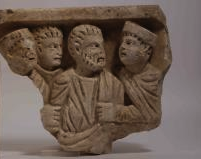Rome: new archaeological site unveiled

sculpture fragment from site
An important new archaeological site was unveiled in Rome today. Located inside the area that belongs to the Basilica of St Paul’s Outside the Walls and its adjoining Benedictine Monastery, extensive digs have revealed what used to be the pumpkin patch tended to by the Benedictine Monks, and show that what today is a complex made up of the Basilica, Bell Tower, Cloister and adjoining Monastery, was once a much larger settlement with a sanctuary for the poor, a well, tower and housing for some 200 people.
While the meticulous work of archaeologists has revealed the layout of the ground and the kind of buildings that surrounded the ancient Basilica of St Paul’s outside the Walls, more than 15,000 ceramic fragments, sculptures and coins give an idea of what the people of the time and their everyday lives, were like.
After a brief welcome speech by Cardinal James Harvey, Archpriest of the Basilica of St Paul, members of the Vatican Museums-backed team who have been collaborating with members of the Pontifical Institute of Christian Archaeology and of Rome’s La Sapienza University, spoke about the importance of the new archaeological site. Six years of hard work on the part of a team of archaeologists, engineers, historians and experts in restoration has revealed what had been a missing link in the history of the city of Rome. In particular it shines the light on the time of Pope John VIII whose chief aim during his pontificate was to defend the Roman state and the authority of the Holy See at Rome from the Saracens.
As Professor Lucrezia Spera of the Pontifical Institute of Christian Archaeology revealed, although there are many literary sources detailing events and costumes of the Early Middle Ages in the city of Rome, until now there were no consistent archaeological remains bearing witness to the period between the 8th and 9th century AD.
Source: VIS/Vatican Radio















